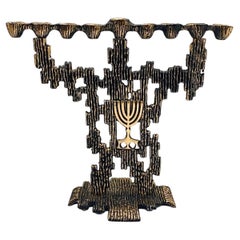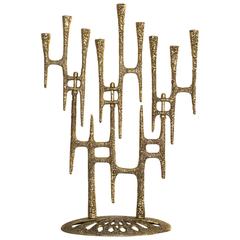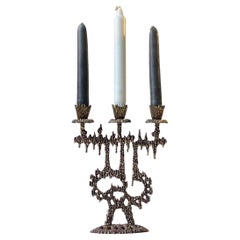Wainberg Brutalist
Mid-20th Century Israeli Brutalist Candelabras
Brass
Recent Sales
20th Century Israeli Brutalist Candlesticks
Brass
Vintage 1960s Israeli Brutalist Candelabras
Bronze
20th Century Israeli Mid-Century Modern Candelabras
Brass
Vintage 1950s Israeli Brutalist Candelabras
Bronze
Vintage 1950s Israeli Brutalist Religious Items
Brass
Late 20th Century Israeli Brutalist Religious Items
Metal
Mid-20th Century Israeli Brutalist Candelabras
Brass
Mid-20th Century Brutalist Candelabras
Brass
People Also Browsed
1990s English Country Dinner Plates
Porcelain
2010s Italian Other Chandeliers and Pendants
Blown Glass
Vintage 1970s American Mid-Century Modern Loveseats
Chrome
Vintage 1970s Italian Mid-Century Modern Chandeliers and Pendants
Chrome
Vintage 1970s American Mid-Century Modern Sectional Sofas
Velvet, Wood
2010s Italian Other Chandeliers and Pendants
Blown Glass
Mid-20th Century American Hollywood Regency Commodes and Chests of Drawers
Wood, Burl
Vintage 1960s American Mid-Century Modern Sofas
Upholstery
Vintage 1970s American Mid-Century Modern Coffee and Cocktail Tables
Brass
Vintage 1980s Hollywood Regency Console Tables
Brass
2010s Italian Mid-Century Modern Chandeliers and Pendants
Brass
Mid-20th Century French Mid-Century Modern Sofas
Fabric
Mid-20th Century German Mid-Century Modern Candlesticks
Metal, Steel
21st Century and Contemporary Italian Mid-Century Modern Sofas
Fabric
Antique Early 1800s Italian Candle Lamps
Brass
21st Century and Contemporary Italian Mid-Century Modern Flush Mount
Brass
A Close Look at Brutalist Furniture
The design of brutalist furniture encompasses that which is crafted, hewn and worked by hand — an aesthetic rebuke (or, at least, a counterpoint) to furniture that is created using 21st-century materials and technology. Lately, the word “brutalist” has been adopted by the realms of furniture design and the decorative arts to refer to chairs, cabinets, tables and accessory pieces such as mirror frames and lighting that are made of rougher, deeply textured metals and other materials that are the visual and palpable antithesis of the sleek, smooth and suave.
ORIGINS OF BRUTALIST FURNITURE DESIGN
- Brutalism emerged during the mid-20th century
- Term coined by architecture critic Reyner Banham
- Originated in the United Kingdom
- Brutalist architecture gained popularity in the United States beginning in the early 1960s
- Inaugural brutalist projects include Unité d'habitation and the city of Chandigarh, India, both of which owe to influential architect Charles-Édouard “Le Corbusier” Jeanneret
- Le Corbusier’s cousin, Pierre Jeanneret, designed hundreds of chairs, tables, cabinets and lamps for Chandigarh
- Informed by the Bauhaus, constructivism, modernism and the International Style; part of mid-century modernism
- Contrasted starkly with Beaux Arts style
CHARACTERISTICS OF BRUTALIST FURNITURE DESIGN
- Use of industrial materials — tubular steel, concrete, glass, granite
- Prioritizes functionalism, minimalism and utilization of negative space
- Spare silhouettes, pronounced geometric shapes
- Stripped-down, natural look; rugged textures, modular construction
- Interiors featuring airy visual flow and reliance on neutral palettes
BRUTALIST FURNITURE DESIGNERS TO KNOW
VINTAGE BRUTALIST FURNITURE ON 1STDIBS
The term brutalism — which derives from the French word brut, meaning “raw” — was coined by architecture critic Reyner Banham to describe an architectural style that emerged in the 1950s featuring monumental buildings, usually made of unornamented concrete, whose design was meant to project an air of strength and solidity.
Le Corbusier essentially created the brutalist style; its best-known iterations in the United States are the Whitney Museum of American Art, which was designed by Marcel Breuer, and Paul Rudolph's Yale Art and Architecture Building. The severe style might have been the most criticized architectural movement of the 20th century, even if it was an honest attempt to celebrate the beauty of raw material. But while the brutalist government buildings in Washington, D.C., seemingly bask in their un-beauty, brutalist interior design and decor is much more lyrical, at times taking on a whimsical, romantic quality that its exterior counterparts lack.
Paul Evans is Exhibit A for brutalist furniture design. His Sculpture Front cabinets laced with high-relief patinated steel mounts have become collector's items nonpareil, while the chairs, coffee table and dining table in his later Cityscape series and Sculpted Bronze series for Directional Furniture are perhaps the most expressive, attention-grabbing pieces in American modern design. Other exemplary brutalist designers are Silas Seandel, the idiosyncratic New York furniture designer and sculptor whose works in metal — in particular his tables — have a kind of brawny lyricism, and Curtis Jere, a nom-de-trade for the California team of Curtis Freiler and Jerry Fels, the bold makers of expressive scorched and sheared copper and brass mirror frames and wall-mounted sculptures.
Brutalist furniture and sculptures remain popular with interior designers and can lend unique, eccentric, human notes to an art and design collection in any home.
Find authentic vintage brutalist chairs, coffee tables, decorative objects and other furniture on 1stDibs.


